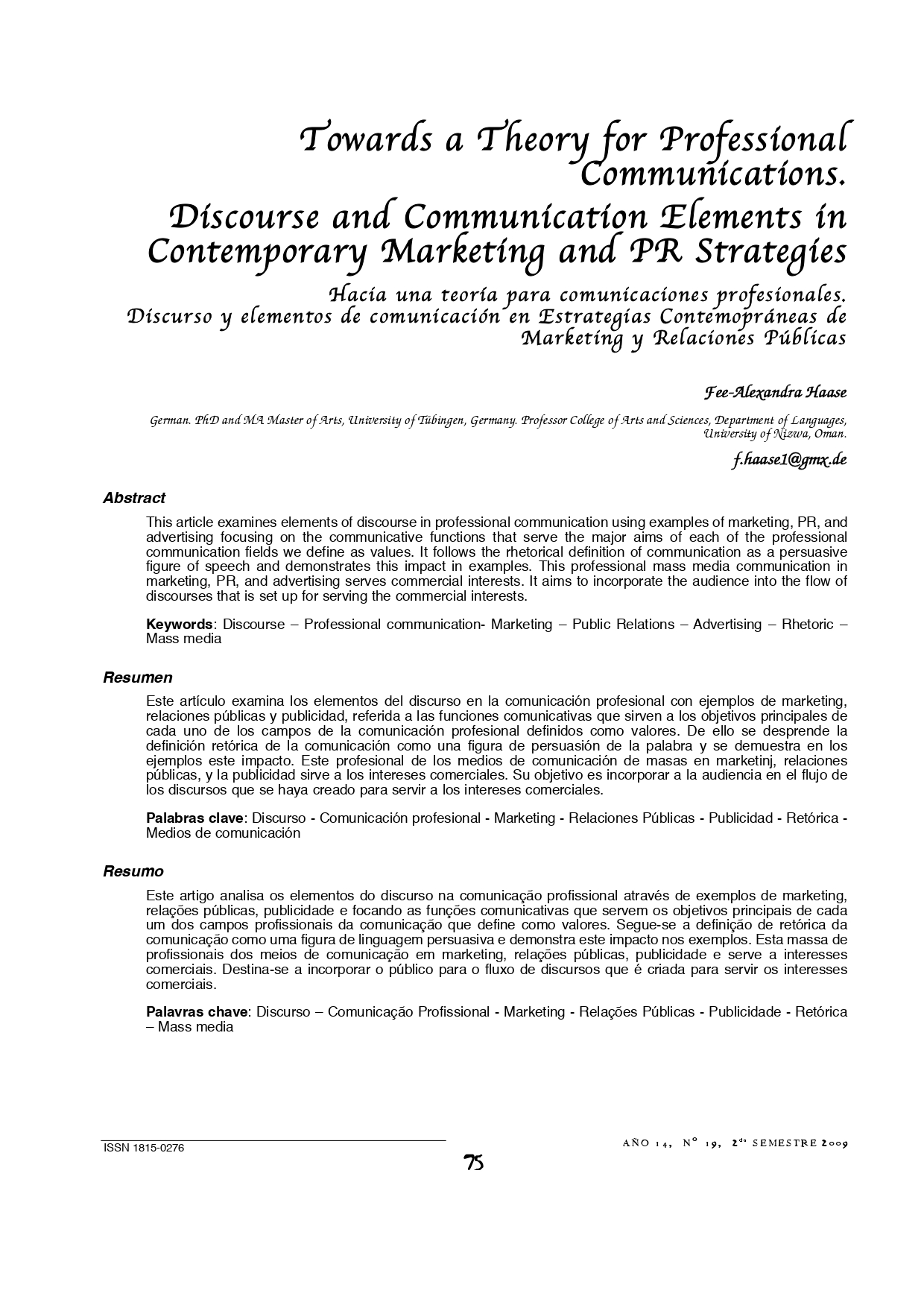Hacia una teoría para comunicaciones profesionales. Discurso y elementos de comunicación en Estrategias Contemopráneas de Marketing y Relaciones Públicas
Palabras clave:
Discurso, Comunicación profesional, Marketing, Relaciones Públicas, Publicidad, Retórica, Medios de comunicaciónResumen
Este artículo examina los elementos del discurso en la comunicación profesional con ejemplos de marketing, relaciones públicas y publicidad, referida a las funciones comunicativas que sirven a los objetivos principales de cada uno de los campos de la comunicación profesional definidos como valores. De ello se desprende la definición retórica de la comunicación como una figura de persuasión de la palabra y se demuestra en los ejemplos este impacto. Este profesional de los medios de comunicación de masas en marketinj, relaciones públicas, y la publicidad sirve a los intereses comerciales. Su objetivo es incorporar a la audiencia en el flujo de los discursos que se haya creado para servir a los intereses comerciales.
Citas
Anheuser-Busch International Advertising and Marketing Code. Anheuser-Busch, Inc.
“Brand Image”. Glossary. Esomar.
“Perspicuitas”. Archimedes Project. Harvard University.
“AIDA” Glossary of Marketing Communications Terminology. MSH Marketing Group.
“Buzz”. Glossary of Marketing Communications Terminology. MSH Marketing Group.
“Buzzword”. Glossary of Marketing Communications Terminology. MSH Marketing Group.
“Copywriting”. Glossary of Marketing Communications Terminology. MSH Marketing Group.
“Corporate Credibility, PR-Style.” Center for Media and Democracy. PR-Watch.
“Discourse Analysis”. Online Dictionary of the Social Sciences. Athabasca University.
“Medium”. Dictionary of Marketing Terms. 3rd edition. Ed. Jane Imber and Betsy-Ann Toffler. Barronʼs Educational Series, Inc. 2000. Answers.
Word of Mouth: The Marketing Figures.” Ibrian. May 18, 2008.
“Write Design Glossary of Marketing Research Terms”. Write Design Online.
American Marketing Association. “Statement of Ethics”. Website American Marketing Association.
Amossy, Ruth. “How to Do Things with Doxa: Toward an Analysis of Argumentation in Discourse.” Poetics Today 23, 3 (2002): 465-487
Anonymus. Rhetorica ad Herennium. Tr. Harry Caplan. University Chicago.
Aristotle. Rhetoric. Ed. Lee Honeycutt. Iowa State University.
Balkin, Jack M. “How Mass Media Simulate Political Transparency.” Yale University.
Boles, Derek. “Language of Media Literacy: A Glossary of Terms”. Center for Media Literacy.
Bottle PR. Glossary. Bottle PR.
Boyd, Josh. “The Rhetoric of Arrogance. The Public Relations Response of the Standard Oil Trust.” Public Relations Review 27, 2 (2001): 163-178
Bullard, Jerry. “The AIDA Formula For Copywriting”. Ezine Articles.
Channel Venture. “A Market Glossary”. The Channel Professional.
Cicero, Marcus Tullius. Academica. Project Gutenberg.
De Chernatony, L. McDonald, Malcolm. Creating Powerful Brands in Consumer, Service and Industrial Markets. Boston [Mass.] Butterworth-Heinemann, 2003.
DeRosia, Eric D. “The Effectiveness of Nonverbal Symbolic Signs and Metaphors in Advertisements: An Experimental Inquiry.” Psychology and Marketing 25, 3 (2008): 298 – 316. Interscience.
Dougherty, Debbie S.; Kramer, Michael W.; Klatzke, Stephanie R.; Rogers, Teddy K. K. “Language Convergence and Meaning Divergence: A Meaning Centered Communication Theory.” Communication Monographs 76, 1 (2009): 20-46
Durand, Jacques. “Rhetoric and the Advertising Image”. Tr. Theo van Leeuwen. Curtin University of Technology.
Edelman, Richard. “Letʼs Make the Argument”. Release September 14, 2008. Edelmann PR.
Goldstein, Frank L.; Findley, Benjamin F. Psychological Operations: Principles and Case Studies. Maxwell Air Force Base, Ala Air University Press, 1996.
Heath, Robert L. “A Rhetorical Perspective on the Values of Public Relations: Crossroads and Pathways Toward Concurrence. Abstract.” Journal of Public Relations Research 12. 1 (2000): 69-91. Leaonline.
Hill, Elizabeth. OʼSullivan, Catherine. OʼSullivan, Terry. Creative Arts Marketing. Boston: Butterworth-Heinemann, 2003.
Ind, Nicholas. Beyond Branding: How the New Values of Transparency and Integrity Are Changing the World of Brands. London : Kogan Page, 2005.
Johansson, Troels Degn. Toward a Meta-Rhetoric of Pictorial Media: Specificity, Pictorality and Compound Signs. University of Copenhagen.
Leps, Marie-Christine. “Critical Productions of Discourse: Angenot, Bakhtin, Foucault.” The Yale Journal of Criticism 17.2 (2004): 263 286.
Mackey, Steve. “Using the Rhetorical Turn to Grasp the Full Importance of Public Relations .“ Paper presented at the annual meeting of the International Communication Association, Marriott Hotel, San Diego, CA, May 27, 2003 Online. All Academic.
Mann, Doug. Structural Idealism: A Theory of Social and Historical Explanation. Waterloo: Ont Wilfrid Laurier University Press, 2002.
McQuarrie, Edward F. and David Glen Mick. Figures of Rhetoric in Advertising Language. Printed version in the March 1996 issue of the Journal of Consumer Research. Santa Clara University.
MediaMiser. PR Glossary. MediaMiser.
Member Code of Ethics 2000. Public Relations Society of America.
Miller, Gerald R.; Nicholoson, Henry E.; Mendelsohn, Harold. “An Integrative Approach for the Accretion of Mass Communication Theory.” Journal of Applied Communications Research 7.1 (1979): 1-7.
Peirce, Charles S. ʻUniverse (2)ʼ, DPP 2 / CP 2.536, 1902. The Commens Dictionary of Peirceʼs Terms. Peirceʼs Terminology in His Own Words. Ed. Mats Bergman and Sami Paavola. Helsinki University Bulletin Online.
Quintilian, Marcus Fabius. Institutio Oratoria. Forum Romanum.
Roberts, K. G. “Exercises in Rhetorical Form: Teaching Public Relations from a Praxis Perspective.” Prism 4.1 (2006). Prism.
Samarasinghe, Stanley W. “Conceptualizing a Strategic Communication Process Model for Crisis-Mode Public Relations} Management”. CERTI.
Smith, Ronald D. Strategic Planning for Public Relations. 3rd ed. New York: Routledge, Taylor and Francis Group, 2009.
Solomon, Robert C. Thinking About Feeling: Contemporary Philosophers On Emotions. Oxford, New York: Oxford University Press (US), 2004.
The Olden Time Series. Vol. 4: Quaint and Curious Advertisements Gleanings Chiefly from Old Newspapers of Boston and Salem, Massachusetts. Ed. Henry M. Brooks. Project Gutenberg.
Uribe-Salazar, Agustín de. Communication Creates Value. Frontline Online. International Public Relations Association.
Visual Rhetoric. Course on Visual Rhetoric at James Madison University. Wiki-Books.

Descargas
Publicado
Cómo citar
Número
Sección
Licencia
Derechos de autor 2009 Revista Punto Cero

Esta obra está bajo una licencia internacional Creative Commons Atribución-NoComercial 4.0.




